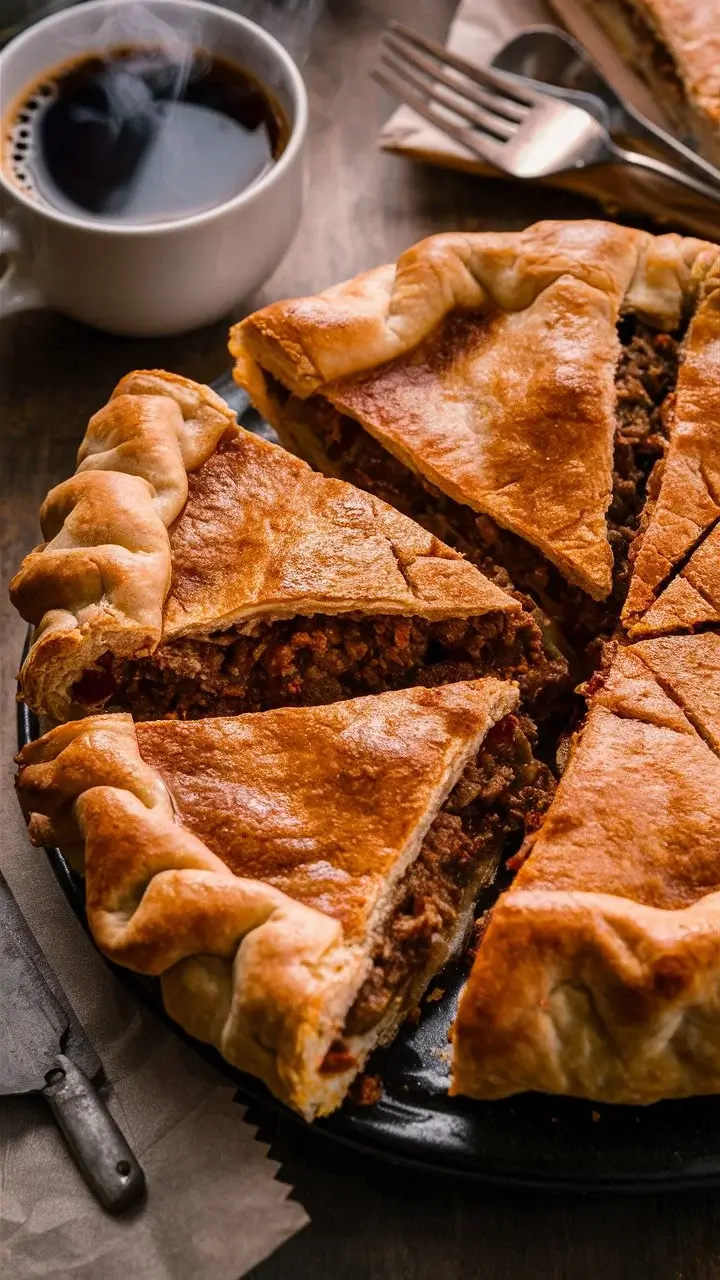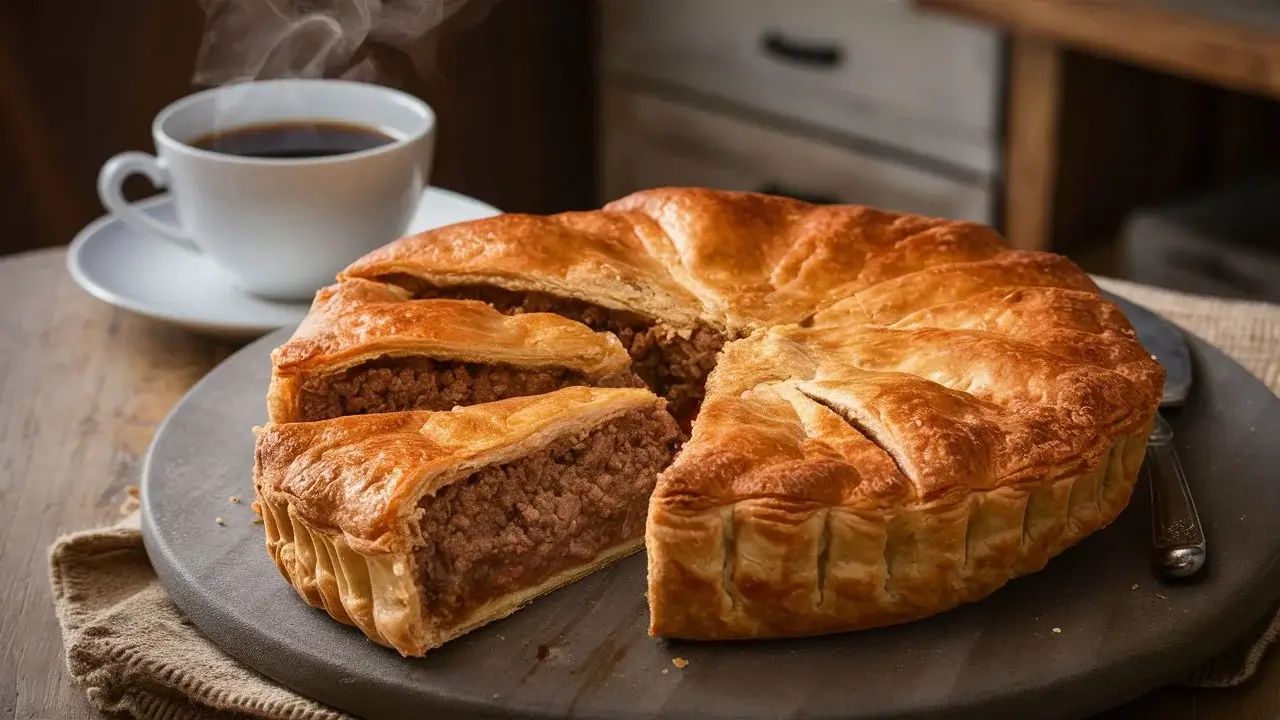If you’re someone who appreciates the art of delicious pies, you’ve likely encountered the captivating allure of Tourtière. This iconic meat pie, deeply rooted in the culinary traditions of Quebec, has been gracing festive tables for generations, evoking a sense of nostalgia and comfort with every bite. However, in this culinary exploration, we’ll delve into the realm of potato-free Tourtière recipes, unveiling the authentic flavors and techniques that have withstood the test of time.

Ingredients
- 2 1/2 pounds of ground pork (preferably organic and locally sourced)
- 1 1/2 cups of cold water
- 1 cup of finely chopped onion
- 1/2 cup of finely chopped celery
- 1 teaspoon of ground black pepper
- 2 bay leaves
- 1 teaspoon of dried savory (or a pinch of marjoram as a substitute)
- 1/2 teaspoon of dried rosemary
- 1/2 teaspoon of grated nutmeg
- 1/2 teaspoon of cinnamon
- Salt to taste
- 1/2 cup of old-fashioned rolled oats
- Pastry dough for two double-crust 9-inch pies
- 1 egg, beaten, for the glaze
Timing
| Preparation Time | Cooking Time | Total Time |
| 1 hour | 55 minutes | 1 hour and 55 minutes |
How to Make Tourtiere recipe without potatoes: Step-by-step
Step 1- Crafting the Filling: In a large, heavy-bottomed skillet or Dutch oven, combine the ground pork with the cold water and bring the mixture to a boil. This initial step ensures that the filling retains a delightfully moist and soupy consistency.
Step 2- Layering the Flavors: Once the mixture reaches a boil, introduce the chopped onions, celery, black pepper, bay leaves, savory (or marjoram), rosemary, nutmeg, and cinnamon. Reduce the heat to medium-low, cover the pot, and allow the flavors to mingle harmoniously for approximately 1 1/4 hours, stirring occasionally. If the mixture appears to be drying out, add a splash of water to maintain the desired consistency.
Step 3- Seasoning to Perfection: Halfway through the cooking process, taste the filling and adjust the seasoning with salt according to your preference. Remember, the saltiness will intensify as the filling cooks down, so it’s better to start with a conservative amount and adjust as needed.
Step 4- The Binding Agent: Once the filling has reached the desired flavor profile, stir in the old-fashioned rolled oats. This addition not only enhances the texture but also helps to bind the filling together, creating a cohesive and satisfying bite.
Step 5- Cooling and Assembling: Remove the bay leaves from the filling and allow it to cool until it reaches a lukewarm temperature. This step is crucial as adding a piping hot filling to the pastry dough can lead to a soggy crust.
Step 6- Pastry Perfection: While the filling cools, prepare the pastry dough for two double-crust 9-inch pies according to your preferred recipe or store-bought option. Line two pie plates with the bottom crust, and evenly distribute the cooled filling between them.
Step 7- Sealing the Deal: Brush the outer edge of the bottom crust with the beaten egg, which will act as a natural adhesive. Carefully place the top crust over the filling, pressing gently around the edges to seal the pies. Trim any excess dough, crimp the edges decoratively, and cut a few steam vents in the top crust to allow for proper ventilation during baking.
Step 8- The Final Touch: For an irresistible golden sheen, brush the top crust with the remaining beaten egg, ensuring an even coating.
Step 9- Baking to Perfection: Preheat your oven to 425°F (218°C). Place the assembled pies on the middle rack and bake for 15 minutes. Then, reduce the oven temperature to 375°F (190°C) and continue baking for an additional 25 minutes, or until the crust achieves a deep, golden hue.

Serving Suggestions: Elevating the Tourtière Experience
While Tourtière is undoubtedly a star in its own right, complementing it with the right accompaniments can take your dining experience to new heights. Consider offering an assortment of condiments such as ketchup, chili sauce, or a variety of mustards (regular, honey, or grainy) to balance the richness of the pie. Pickled vegetables, like pickled beets or quick-pickled vegetables, can also provide a refreshing contrast to the savory flavors.
For a complete meal, pair your Tourtière with a fresh, crisp salad or steamed vegetables, allowing the pie to take center stage while providing a lighter counterpoint to the hearty filling.
Freezing and Reheating: Convenience at Its Finest
One of the beauties of Tourtière is its freezer-friendly nature, making it an ideal option for batch cooking or meal prepping. You can freeze the assembled pies before baking by wrapping them tightly in plastic wrap and aluminum foil. When you’re ready to enjoy them, simply remove the wrapping, brush the top crust with beaten egg, and bake the frozen pies at 375°F (190°C) until golden brown and heated through, allowing for an extended baking time of approximately 50 minutes.
Alternatively, you can bake the pies first, cool them completely, and then wrap and freeze them for up to 4 months. To reheat, place the frozen Tourtière in a preheated 350°F (175°C) oven, loosely covered with foil, and bake until a knife inserted into the center comes out hot, indicating that the filling has reached the desired temperature.
Embracing Tradition: The Enduring Legacy of Tourtière
Tourtière is more than just a culinary delight; it’s a testament to the rich heritage and traditions of French-Canadian culture. Passed down through generations, this savory pie has graced countless festive tables, evoking cherished memories and fostering a sense of community. By embracing this potato-free version, you’re honoring the authentic flavors and techniques that have been meticulously preserved over time.
Nutritional Facts
- Calories: 4506
- Total Fat: 32g
- Saturated Fat: 11g
- Cholesterol: 82mg
- Sodium: 195mg
- Total Carbohydrates: 22g
- Dietary Fiber: 1g
- Protein: 19g
Conclusion
Tourtière, with its rich history and captivating flavors, is a true testament to the enduring culinary traditions of French-Canadian culture. By embracing this potato-free version, you’re not only honoring the authentic essence of this savory pie but also ensuring that its legacy lives on for generations to come. So, gather your ingredients, roll up your sleeves, and embark on a culinary journey that will transport you to the heart of Quebec’s culinary heritage, one delectable bite at a time.
FAQs
Can I substitute the ground pork for another type of meat?
While ground pork is the traditional choice for Tourtière, you can experiment with other ground meats like beef or a combination of pork and beef. However, keep in mind that using different meats may alter the flavor profile slightly.
Is it necessary to use rolled oats in the filling?
The addition of rolled oats serves as a binding agent and enhances the texture of the filling. If you prefer a smoother consistency, you can omit the oats, but be aware that the filling may be slightly looser.
Can I make Tourtière ahead of time?
Absolutely! Tourtière is an excellent make-ahead dish. You can assemble the pies and freeze them before baking, or bake them first, cool them completely, and then freeze for later use. This makes Tourtière a convenient option for busy weeknights or holiday gatherings.
What is the best way to reheat a frozen Tourtière?
If you’ve frozen the Tourtière before baking, simply remove it from the freezer, brush the top crust with beaten egg, and bake it from frozen at 375°F (190°C) until golden brown and heated through, allowing for an extended baking time. If you’ve frozen a pre-baked Tourtière, reheat it in a preheated 350°F (175°C) oven, loosely covered with foil, until a knife inserted into the center comes out hot.
Can I make a vegetarian or vegan version of Tourtière?
While Tourtière is traditionally a meat-based dish, you can certainly experiment with plant-based protein alternatives like lentils, mushrooms, or meat substitutes to create a vegetarian or vegan version. However, keep in mind that the flavor profile will differ from the traditional recipe.
Remember, the beauty of Tourtière lies in its versatility and the ability to adapt it to your personal preferences while still honoring its rich culinary heritage. Embrace the joy of experimentation, and let your taste buds guide you on this delectable journey through the flavors of French-Canadian cuisine.